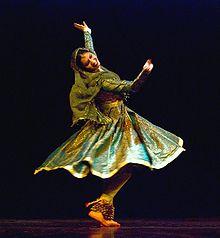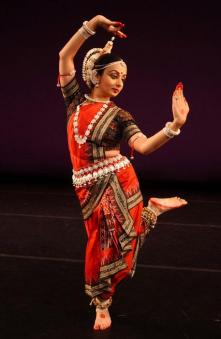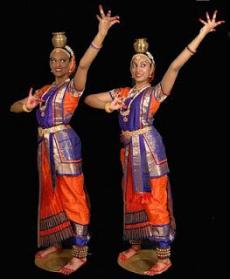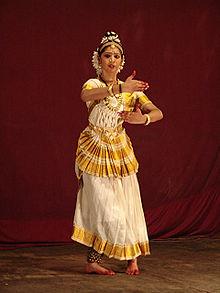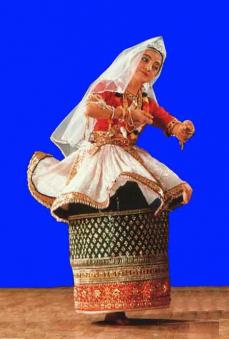Indian classical dance
Indian dance is inseparable from the Indian culture.
Indian dance is divided into three distinct categories: natya (drama), nritya (interpretive dance performed along with the lyrics sung on a melodic tune and nritta (pure dance, during which the body movements do not express a particular state of mind and do not carry a semantic message).
Another type of classification distinguish between the tandava dance, which means the male dance of Shiva and lasya dance, the feminine aspect of the dance of Parvati, the consort of Lord Shiva.
The Indian Dance Classics are derived from the Vedas and Natya Shastra, literally meaning "An encyclopedia on Dance", a sacred text on drama codes, written from 200BC to 200AD. The religious aspect is very present in the Indian dance.
Indian classical dances and folk dances (specific to customs and festivals from each region) greatly influenced the Indian Movie Dance or the Bollywood Dance.
Classical dances of India
The Indian Dance Federation recognizes eight types of Classic Dances, those being the Bharatnatyam, Kathak, Mohini-attam, Kucchipudi, Manipuri, Kathakali, Orissi and Satriya.
Bharata Natyam dance
Originated from Southern India, Bharata Natyam is considered the oldest form of Indian classical dance. Long time ago it was performed only in temples by dancers (the Devadasi) who had dedicated their lives to their art and to the gods. Today it left the temples for the stage.
The dancer uses the body gestures (mudras), but also the composition of emotions through facial expressions (abhinaya).
The scene is organized precisely. To the left side of the stage, in public view, there are the musicians and the (s) singer (s) led by the nattuvanar that gives the rhythm with small cymbals (the talams). The rhythm of the dance will be supplied by a percussionist playing a mridangam. The orchestra can be composed of a flute player and a vina player. The music is of Carnatic type. To the right side of the stage there is installed a statue of Shiva in its form of Nataraja, the god of dance. The dancer enters from the right side, salutes the divinity, the stage, the musicians and the audience.
Kathak dance
In Sanskrit, kathak means "history." This dance form traces its origins to the nomadic bards of ancient northern India, known as Kathakars or storytellers.
From the 16th century onwards, Kathak has been influenced by Islamic art brought by the Mughals. This is a very rhythmic dance in which the music accompaniment gives the pace to the dancers. Musicians use percussion instruments (tabla, pakhawaj) but also more melodic instruments (sitar, harmonium ...). The dancers respond to the music with the little bells they wear at their ankles.
The rapid spins alternate with statuesque poses. Kathak, unlike the Bharata Natyam, focuses more on the dancer's feet movements than on the hand gestures.
Odissi dance
The Odissi comes from the state of Orissa, from eastern India. Dating back more than 2000 years, the dance originates from the worship of Krishna. Sculptures of Odissi dancers were found on the walls of some temples like those of Konarak and Puri.
The Odissi dance is very faithful to the choreographic traditions of Natyashastra. The dance is based on the principle of tribhang that divides the body of the dancer into three parts: the head, the chest and the torso. The complicated movements of these body parts make appear the emotions and the expressions.
A typical recital is the theme of the love between Krishna and Radha. The dancer's interpretation is a subtle blend of pure dance and expressive dance. The musical accompaniment consists of Carnatic music and hindustanique music.
Kuchipudi dance
Kuchipudi originates from the village of Kuchipudi (Kuchelapuram), in the state of Andhra Pradesh in southern India. It was once performed in temples and in groups. Originally it was reserved for Brahmins who played the female roles. Today, Kuchipudi is also danced by women and sometimes as a solo presentation.
The performance begins with prayers and traditional offerings. The dancers present themeselves during the daru - small dance scene that enhances the personality of the characters and the skill of the dancers.
Kuchipudi is famous because of the fluidity of the movements of the dancers and of the Carnatic rhythmic music that accompanies them. The orchestra is composed of musicians (mridangam, flute, cymbals, harmonium), a singer and a nattuvanar who runs everything. Among the many figures, we can see the tarangam, the dance in which the dancer's feet are gripping the edges of a plate, swinging a pot full of water on the head ...
Mohiniattam dance
The Mohiniattam, literally meaning "the enchanting dance" is a sacred dance performed in the southwestern India. The term comes from the words "Mohini" meaning "the woman who's charms strikes the sight" and "attam" which refers to the grace of movement.
In ancient times, the Mohiniattam was performed by the devadâsî in temples of Kerala. The Mohiniattam recounts two stories from Hindu mythology, on the god Vishnu. In the first, Vishnu takes the form of a mohini to bewitch the asura demons who had stolen from the gods the nectar of immortality. Before the fascinated demons, Vishnu distributes the amrita to the other gods. In another story, Vishnu becomes a mohini to disturb the spirit of Bhasmasura and deliver Shiva held captive by the devil.
The Mohiniattam is characterized by large and delicate movements, and extremely graceful gestures of the head and hands. With eye movements and expression, the dancer must bewitch the mind without arousing sensuality. The dancer is wearing a Kasavu, a white sari with a golden border.
Manipuri dance
Manipuri originates from the state of Manipur, in north-eastern India. Always performed in temples, this dance is still very close to the life of the local population.
The Manipuri dancers wear veils and wide dresses on which there are hundreds of small circular mirrors. They dance slowly. Unlike other forms of Indian dances, the face of the dancer remains still. It is accompanied by a percussionist who dances shirtless while playing his instrument, the pung. Compared to the dancer, his pace is much faster, even frantic. There is therefore a strong contrast between the swaying gait of the dancer and the strength of the man.
Last edited: 05/07/2021

























